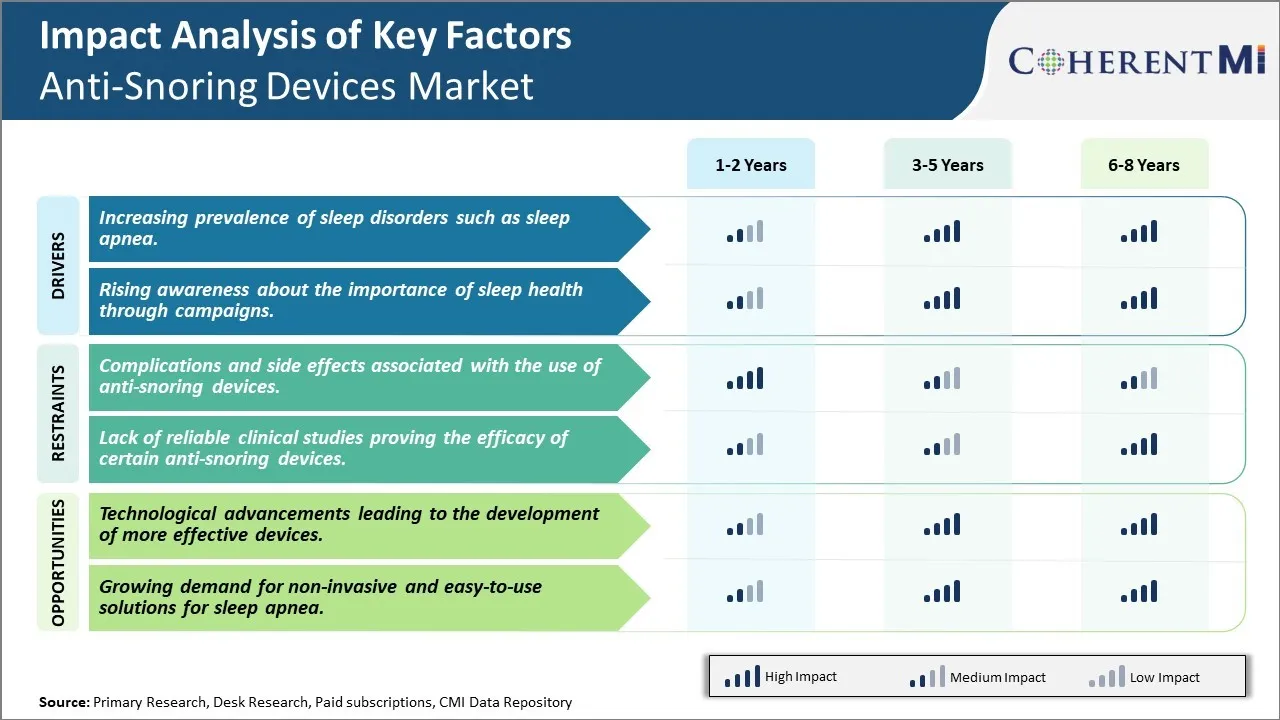反打呼设备市场 规模与份额分析 - 成长趋势与预测 (2024 - 2031)
反打呼设备市场被分割 按设备类型(单管推进装置、舌稳定装置、连续正气压装置、其他)、分配渠道(医院和零售药店、在线药店、其他)、地理(北美、拉丁美洲、亚太、欧洲、中东和非洲)。 本报告为上述部分提供了价值(10亿美元)。....
反打呼设备市场 趋势
市场驱动器 -- -- 睡眠安眠等睡眠障碍的发病率上升
世界各地各种睡眠障碍,如睡眠安眠,日益普遍,是防打呼的装置市场的主要驱动力。 睡眠阿普涅亚(Sleep apnea)是指一种可能严重的睡眠障碍,在睡眠中扰乱一个人的正常呼吸模式. 有各种类型的睡眠安眠药,但最常见的是阻塞睡眠安眠药,其中肌肉在睡觉时在喉咙周围放松,阻断呼吸道,导致呼吸短暂停止. 人通常会在上气道肌肉再次放松时,以突然的吸气或窒息的声音重新开始呼吸. 睡眠 apnea 会导致血液中的氧气含量下降,这扰乱了人们的睡眠,因为症状可以持续到整个晚上。
根据各种估计,目前全世界有超过10亿人患上安眠症,估计男性的发病率高达38%,女性高达16%。 老年人口的这一比率甚至更高。 主要原因可能从肥胖和超重增殖到衰老和遗传学. 阻碍睡眠的阿普涅亚和中央睡眠的阿普涅亚都扰乱了自然睡眠的夜晚,并阻止人掉入深沉,梦幻的睡眠阶段,需要在早晨感到清新. 长期影响可能助长严重的健康问题,如高血压、心脏病、糖尿病和中风,如果得不到治疗。
中度至重度睡眠安非他明的标准治疗方案涉及CPAP疗法,该疗法在睡眠期间通过面具提供持续的正气压,以保持气道畅通. 然而,由于诸如不适、口干和幽闭恐惧症等问题,使替代性治疗办法具有吸引力,加入《行动计划》始终是一项挑战。 这里的防打呼噜装置作为缓解打呼噜的有效方法,也干扰了伴侣的睡眠. 口罩和鼻腔装置有助于改善呼吸,在睡眠期间打开呼吸道,减少呼吸停止的发生。 因此,全球睡眠安非他明日益加重的疾病负担刺激了对防打呼啸装置的需求,以此作为治疗和预防措施。
市场驱动力 -- -- 通过运动提高对睡眠健康重要性的认识
公众日益认识到保持健康睡眠卫生的重要性和与睡眠不足有关的风险,这是促使更多采用防打呼噜装置的另一个关键因素。 各种社交媒体运动、网络博客以及平面媒体的文章都凸显了睡眠中断对健康、生产力和福祉的不利影响等问题。 人们意识到,由于生活方式更加繁忙,工作压力很大,无法进行高质量的睡眠,因此他们需要积极主动地采取措施,在睡眠问题成为长期问题之前加以解决。
非营利组织以及政府开展的运动侧重于教育特别是年轻的白领专业人员、新父母和老年人了解基本的睡眠提示,排除噪音干扰,如早期打呼噜,以及了解不良睡眠与糖尿病、肥胖等疾病之间的联系。 健康睡眠应当是优先的讯息,而不会受到损害,这一直是一个重要的外卖。 与此同时,技术进步使获得共同睡眠条件的简单工具民主化。 与处方睡眠辅助器械相比,社会上可接受的防打鼻涕装置是一种较好的治疗方法,给人留下了令人鼓舞的印象。
反鼻制品制造商也通过有效的数字营销运动补充了提高认识的举措,强调积极的审查和检验。 这种谨慎、易于使用的形象促使人们接受这些装置供个人使用,甚至用于赠送礼物。

市场挑战 - 与使用防吸设备有关的并发症和副作用
防吸装置市场面临的主要挑战之一是与使用这些装置有关的并发症和副作用。 反打呼设备通过改变气道或下颚定位的结构而起作用,这种结构有时会导致用户的不适,疼痛或其他问题. 例如,调整下颚定位的口具可能会因为长时间使用而引起牙齿对接问题或节奏性关节(TMJ)不适. 鼻设备使用带子或夹子绕鼻子,可能导致敏感用户的刺激、拥堵或鼻出血。 一些装置还改变自然呼吸模式,这种呼吸模式可能导致某些个人呼吸短促、口干或头痛。 某些防打呼的装置的侵入性以及它们诱导鼻,口或喉部微妙结构的变化,使并发症成为一种固有的风险,限制了广泛采用. 设备制造商需要注重改进设计,使产品在长时间内更容易使用,以减少对更大的消费基础产生副作用的风险。 有效解决并发症是阻碍该行业进一步增长的一项挑战。
市场机会 -- -- 导致发展更有效装置的技术进步
反扫荡装置市场的一个关键机会领域是导致研制更有效装置的技术进步。 不断的创新正在引进新的产品类别和更好的产品设计,这些产品设计能更有效地处理打呼的问题。 例如,采用呼吸测谎法可以更精确地跟踪睡眠模式,帮助开发口服器械,更好地瞄准阻碍睡眠的阿普内亚. 材料的进步使得可以使用自在硅酮或记忆泡沫制成的轻量级耐用装置,而不是过去较散装的塑料选项。 电子传感器和跟踪为监测遵守情况和自动调整提供了可能性。 快速原型可以方便、低成本地试验新的原型。 越来越多的保健数字化也为与睡眠监测应用软件和远程诊断连接提供了新的机会。 总体而言,持续的创新扩大了治疗范围,改善了反打呼装置的用户体验,为行业参与者探索和推动未来增长提供了良机.